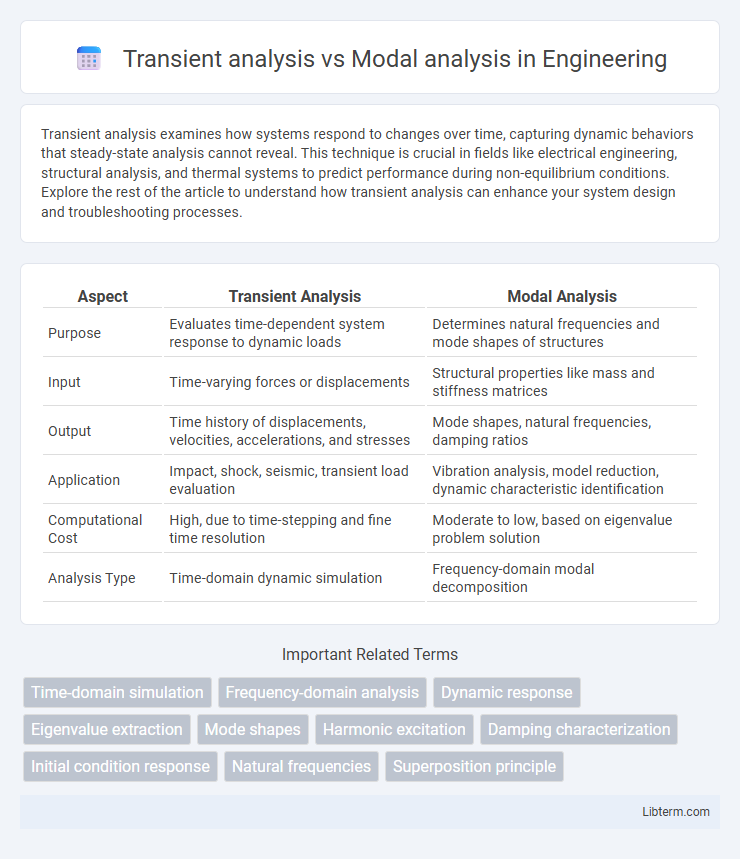Transient analysis examines how systems respond to changes over time, capturing dynamic behaviors that steady-state analysis cannot reveal. This technique is crucial in fields like electrical engineering, structural analysis, and thermal systems to predict performance during non-equilibrium conditions. Explore the rest of the article to understand how transient analysis can enhance your system design and troubleshooting processes.
Table of Comparison
| Aspect | Transient Analysis | Modal Analysis |
|---|---|---|
| Purpose | Evaluates time-dependent system response to dynamic loads | Determines natural frequencies and mode shapes of structures |
| Input | Time-varying forces or displacements | Structural properties like mass and stiffness matrices |
| Output | Time history of displacements, velocities, accelerations, and stresses | Mode shapes, natural frequencies, damping ratios |
| Application | Impact, shock, seismic, transient load evaluation | Vibration analysis, model reduction, dynamic characteristic identification |
| Computational Cost | High, due to time-stepping and fine time resolution | Moderate to low, based on eigenvalue problem solution |
| Analysis Type | Time-domain dynamic simulation | Frequency-domain modal decomposition |
Introduction to Structural Analysis Techniques
Transient analysis examines time-dependent dynamic responses of structures subjected to varying loads, capturing the evolution of stresses, strains, and displacements over time. Modal analysis identifies a structure's natural frequencies, mode shapes, and damping ratios, providing critical insight into its vibrational characteristics and resonance behavior. Both methods are fundamental in structural analysis, enabling engineers to predict performance under dynamic conditions and design safer, more efficient structures.
Understanding Transient Analysis
Transient analysis evaluates a system's response to time-dependent inputs, capturing dynamic changes and non-steady-state behavior over specific time intervals. It models phenomena like vibrations, shocks, and thermal fluctuations by solving time-domain differential equations, providing detailed insight into performance during transient events. This contrasts with modal analysis, which identifies natural frequencies and mode shapes but does not capture time-dependent evolution or non-linear effects.
Overview of Modal Analysis
Modal analysis identifies natural frequencies, mode shapes, and damping characteristics of structures to predict dynamic behavior under vibrational loads. It provides essential insights into resonance phenomena and helps engineers design components to avoid destructive oscillations. This technique complements transient analysis, which evaluates time-dependent response to dynamic excitations.
Core Differences Between Transient and Modal Analysis
Transient analysis examines a structure's time-dependent response to dynamic loads, capturing how displacement, stress, and strain evolve over time under varying forces. Modal analysis identifies the natural frequencies and mode shapes of a system, enabling prediction of resonant behavior without time-dependent input. The core difference lies in transient analysis providing detailed time-history results for dynamic events, while modal analysis offers a frequency-based characterization essential for understanding vibration and dynamic stability.
Applications of Transient Analysis
Transient analysis is essential for studying the time-dependent response of structures and systems under dynamic loading, such as impact forces, shock waves, and transient thermal effects. It is widely applied in automotive crash simulations, earthquake engineering, and electrical circuit switching to capture the evolution of stresses, displacements, and temperatures over time. This analysis type provides critical insights into non-steady-state phenomena that modal analysis, which focuses on natural frequencies and mode shapes, cannot capture.
Applications of Modal Analysis
Modal analysis is primarily used in structural engineering to identify natural frequencies, mode shapes, and damping characteristics of a system, enabling the prediction of vibrational behavior under various load conditions. It plays a crucial role in designing aerospace components, automotive parts, and civil structures by optimizing stiffness and minimizing resonance-related failures. Unlike transient analysis, which simulates time-dependent responses to dynamic loads, modal analysis provides foundational data for understanding and controlling vibration patterns in engineering applications.
Advantages and Limitations of Transient Analysis
Transient analysis captures the dynamic response of structures and systems over time, offering detailed insight into time-dependent loads and non-linear behaviors that modal analysis cannot provide. It accurately models complex interactions under variable loading scenarios, making it essential for evaluating shock, impact, and sudden force changes. Limitations include higher computational cost and longer processing times compared to modal analysis, making it less efficient for steady-state or frequency-based assessments.
Pros and Cons of Modal Analysis
Modal analysis provides precise identification of natural frequencies, mode shapes, and damping ratios, enabling efficient design and troubleshooting of mechanical systems. It can simplify complex dynamic behavior into discrete modes, reducing computational effort compared to transient analysis. However, modal analysis may not accurately capture non-linearities, transient responses, or time-dependent loading effects, limiting its applicability in scenarios requiring detailed time-domain simulation.
Choosing the Right Analysis for Engineering Problems
Transient analysis evaluates system behavior over time under time-varying loads, capturing dynamic responses such as shocks or impacts. Modal analysis identifies natural frequencies and mode shapes, essential for understanding vibration characteristics and avoiding resonance. Selecting the right analysis depends on the problem scope: transient analysis suits time-dependent loadings, while modal analysis is ideal for assessing inherent vibrational properties.
Conclusion: Key Takeaways for Engineers
Transient analysis captures time-dependent structural responses under dynamic loads, essential for understanding real-time behavior and stress variations. Modal analysis identifies natural frequencies and mode shapes, enabling prediction of resonant conditions and vibration characteristics. Engineers should combine both methods to ensure comprehensive design validation, optimizing structural integrity and dynamic performance.
Transient analysis Infographic

 libterm.com
libterm.com